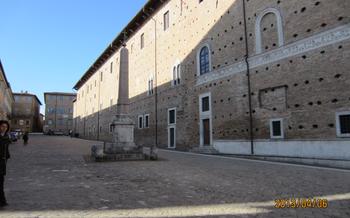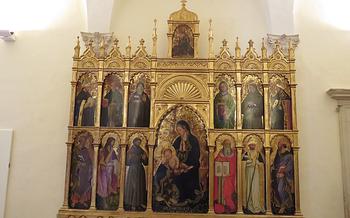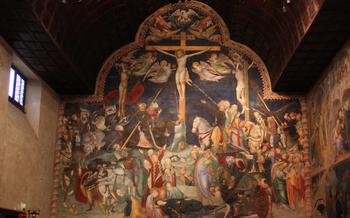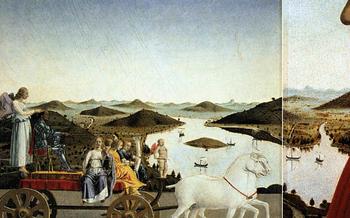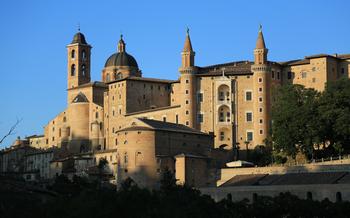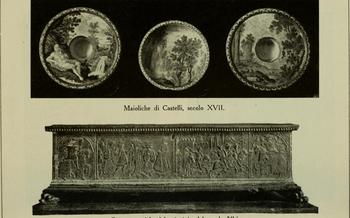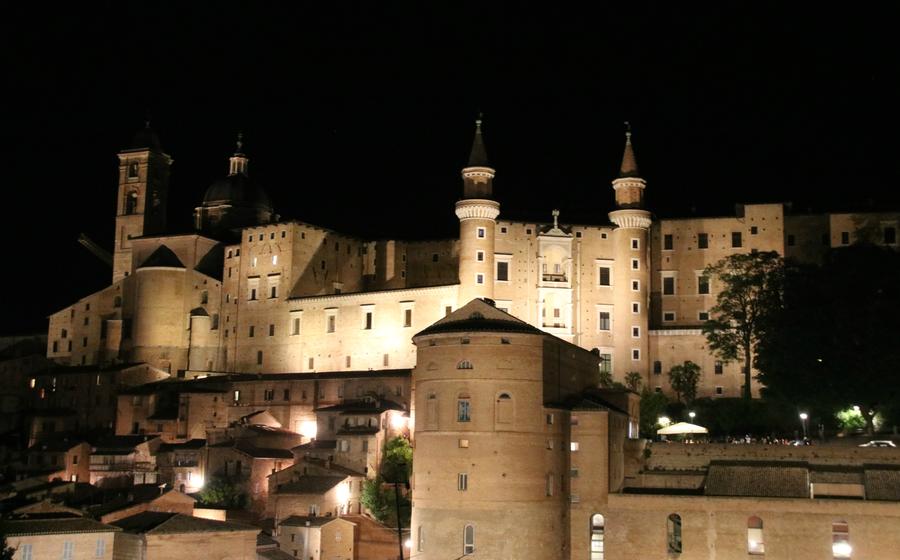
Palazzo Ducale
- Introduction - The Allure of Urbino's Renaissance Gem
- Practical Information
- A Glimpse into Princely Life
- Exploring the Courtyard - A Unique Perspective
- Immerse in the Art - A Treasure Trove of Masterpieces
- The Studiolo of Federico da Montefeltro - A Renaissance Masterpiece
- A Walk Through History - The Salone del Trono
- The Secret Garden - A Hidden Oasis
- The National Gallery of the Marche - A Regional Art Showcase
- The Views from the Torre Campanaria - A Panoramic Vista
- Temporary Exhibitions and Events: Dynamic Cultural Experiences
- Educational Programs and Workshops: Unveiling the Palace's Secrets
- Accessibility and Facilities
- Tips for Photography Enthusiasts
- Insider Tip - Hidden Gems and Secrets:
Introduction - The Allure of Urbino's Renaissance Gem
In the heart of Italy's enchanting Marche region, nestled amidst rolling hills and medieval charm, lies the city of Urbino. A jewel of the Italian Renaissance, Urbino is home to one of the most captivating and awe-inspiring palaces in the country - the Palazzo Ducale.
This architectural masterpiece, commissioned by Duke Federico da Montefeltro in the 15th century, stands as a testament to the power, prestige, and cultural brilliance of the Montefeltro dynasty. The palace's elegant facades, adorned with intricate stone carvings and delicate loggias, blend seamlessly with the surrounding landscape.
Inside, the Palazzo Ducale is a treasure trove of Renaissance art and architecture. Its grand halls, adorned with magnificent frescoes, sculptures, and tapestries, tell the story of a dynasty that reigned over Urbino for nearly two centuries.
Whether you're an enthusiast of art, history, or architecture, or simply seeking a glimpse into the opulent world of the Italian Renaissance, the Palazzo Ducale is an absolute must-visit.
Practical Information
- Location: Piazza Rinascimento, 13, 61029 Urbino PU, Italy
- Timings: 8:30 AM to 7:30 PM, Tuesday to Sunday (closed on Mondays)
- Admission Costs: €50 for adults, €50 for reduced price (students, over 65, groups of 15 or more), free for children under 18
A Glimpse into Princely Life
During my visit to the Palazzo Ducale, I was particularly captivated by the private apartments of the dukes. These lavish chambers, reserved exclusively for the ruling family and their guests, offered a glimpse into the opulent lifestyle of the Montefeltros.
The walls of these apartments were adorned with intricate frescoes, depicting scenes from mythology, history, and daily life. The ceilings were adorned with gilded coffered ceilings, while the floors were covered with colorful majolica tiles. The furniture was equally impressive, with inlaid marquetry, carved wood panels, and sumptuous upholstery.
The highlight of the ducal apartments was the Duchess's Studiolo, a small but exquisitely decorated room where the duchess could retreat for study, contemplation, and prayer. The walls were lined with shelves filled with books, and the ceiling was adorned with a beautiful fresco depicting the constellations.
Exploring the Courtyard - A Unique Perspective
The courtyard of Palazzo Ducale is a visual masterpiece, designed with remarkable harmony and grandeur. As you step inside, you'll be greeted by a harmonious blend of architectural elements that create a truly immersive experience. The open space is surrounded by a portico with elegant arches, supported by slender columns. Look up to admire the Loggia, a covered gallery that runs along the upper level, offering stunning views of the courtyard and the surrounding landscape.
The courtyard's focal point is undoubtedly the Scalone d'Onore, the grand staircase that leads to the upper floors. Its sweeping curves and ornate balustrade add a sense of majesty to the space. Each step of the staircase is carefully designed, showcasing intricate carvings and sculptures that tell stories of the palace's history and lineage.
Take a moment to appreciate the architectural details that make the courtyard so distinctive. The use of perspective, with the receding arches and columns, creates an illusion of depth and draws the eye towards the staircase. The harmonious balance of light and shadow, especially during the golden hours of dawn and dusk, enhances the courtyard's visual appeal, making it a photographer's paradise.
Tip for Photographers:
For a stunning shot of the courtyard, position yourself at the base of the Scalone d'Onore, using a wide-angle lens to capture the grandeur of the staircase and the surrounding architecture. Experiment with different angles to create a unique perspective that showcases the courtyard's harmony and elegance.
Immerse in the Art - A Treasure Trove of Masterpieces
The Palazzo Ducale houses an extensive collection of Renaissance art, showcasing the finest works of some of the period's most renowned masters. Admire the exquisite paintings by Piero della Francesca, whose serene and ethereal style is evident in works like the "Madonna of Senigallia" and the "Flagellation of Christ." Marvel at the intricate details and perspective in Paolo Uccello's "Battle of San Romano," capturing the chaos and drama of the battlefield. And don't miss the delicate and graceful Madonnas by Raphael, whose mastery of form and color radiates throughout his works.
Beyond these iconic artists, the palace's galleries are filled with a wealth of other masterpieces, each telling a unique story. Explore the allegorical paintings depicting classical myths and legends, religious scenes that convey deep spiritual meaning, and portraits that capture the essence of the ducal court. The iconography and symbolism woven into these works offer a glimpse into the cultural and intellectual milieu of the Renaissance, inviting visitors to decode their hidden messages.
To fully appreciate the palace's art collection, allow yourself ample time to wander through the galleries, immersing yourself in the beauty and complexity of each work. Follow a suggested route that takes you chronologically through the different artistic periods, allowing you to trace the evolution of style and technique from the early Renaissance to the High Renaissance. As you move from room to room, let the masterpieces speak to you, transporting you back in time to a period of unparalleled artistic achievement.
The Studiolo of Federico da Montefeltro - A Renaissance Masterpiece
Tucked away within the Palazzo Ducale, the Studiolo of Federico da Montefeltro stands as a testament to the duke's refined taste and love for the arts. This intimate chamber, designed as a private study and retreat, is adorned with exquisite intarsia panels, meticulously crafted from different types of wood. Each panel depicts a symbolic representation of the liberal arts and sciences, mythology, and allegory, forming a complex visual narrative that invites contemplation and interpretation.
The studiolo's iconography is a testament to the duke's humanist ideals and his desire to create a space for intellectual pursuits. The panels feature personifications of virtues, muses, and ancient philosophers, alluding to the importance of knowledge and wisdom. The intricate inlay work showcases the skill and artistry of the craftsmen, who used contrasting woods to create depth and realism in the images.
Among the notable panels is one depicting Federico da Montefeltro himself, seated at his desk, surrounded by books and scientific instruments. This panel reveals the duke's passion for learning and his role as a patron of the arts and sciences. The studiolo, therefore, becomes a symbol of the Renaissance spirit, where the pursuit of knowledge and the appreciation of beauty were highly valued.
An interesting anecdote surrounds the restoration process of the studiolo. In the 19th century, the panels were removed from the walls and sold to various collectors, resulting in their dispersion. Fortunately, through the efforts of dedicated art historians and collectors, the panels were reacquired and returned to their original location. Today, visitors can once again admire the studiolo in its entirety, a testament to the enduring legacy of Federico da Montefeltro's patronage and the enduring power of Renaissance art.
A Walk Through History - The Salone del Trono
A majestic chamber that echoes with tales of power and prestige, the Salone del Trono is the symbolic heart of the Palazzo Ducale. Here, the dukes of Urbino held court, dispensing justice, receiving foreign dignitaries, and celebrating significant events. The walls of the Salone are adorned with a series of monumental frescoes that narrate the illustrious history of Urbino and the Montefeltro dynasty.
These frescoes, painted by some of the most renowned artists of the Renaissance, depict scenes of battles, conquests, and diplomatic encounters. The ceiling, a masterpiece of illusionistic painting, features a trompe-l'œil dome that creates the illusion of an open sky, complete with clouds and cherubs. Among the most striking frescoes is one depicting Federico da Montefeltro triumphantly returning to Urbino after a victorious campaign. The duke is portrayed on horseback, surrounded by his loyal entourage, as he enters the city gates to the cheers of his jubilant subjects.
The Salone del Trono is not merely a showcase of artistic virtuosity but also a testament to the political ambitions and cultural achievements of the Montefeltro family. The frescoes serve as a visual representation of the dukes' power and legitimacy, glorifying their military prowess, diplomatic skills, and patronage of the arts. Visitors to the Salone can immerse themselves in this rich tapestry of history, gaining a deeper understanding of the political and cultural context of Renaissance Urbino.
The Secret Garden - A Hidden Oasis
Nestled within the walls of the Palazzo Ducale, the secret garden offers a tranquil and enchanting escape from the bustling city. With its lush greenery, colorful blooms, and serene atmosphere, this hidden gem is a testament to the refined taste and love for nature of the ducal family.
Crafted in the 15th century, the garden was designed as a private retreat for the dukes and their guests. It features a variety of plants and flowers, including roses, lilies, and fragrant herbs, arranged in intricate patterns. The garden's centerpiece is a beautiful fountain, surrounded by stone benches where visitors can relax and soak in the tranquility.
One of the most fascinating aspects of the secret garden is its connection to the ducal family. It is said that Duke Federico da Montefeltro, a passionate botanist, spent many hours tending to his beloved garden. He would often use the flowers and herbs from the garden to create natural remedies and fragrances.
Visiting the secret garden is like stepping back in time. The air is filled with the scent of flowers and the gentle sound of water flowing from the fountain. It is a place where visitors can escape the crowds and connect with the history and tranquility of the Palazzo Ducale.
For the best experience, visit the secret garden in the early morning or late afternoon when the light is soft and golden. Take your time to explore the garden's hidden nooks and crannies, and enjoy the peace and tranquility of this hidden oasis.
The National Gallery of the Marche - A Regional Art Showcase
Enrich your cultural experience with a visit to the National Gallery of the Marche, housed within the Palazzo Ducale. This gallery showcases a diverse collection of paintings, sculptures, and artifacts that celebrate the artistic heritage of the Marche region.
As you wander through the gallery's elegant halls, you'll encounter masterpieces from various artistic periods and schools. Admire the delicate brushstrokes of Renaissance masters like Piero della Francesca and Giovanni Santi, whose works capture the essence of the era. Don't miss the captivating sculptures by Francesco Laurana and Agostino di Duccio, which display exquisite craftsmanship and attention to detail.
Among the highlights of the collection is the breathtaking "Madonna of Senigallia" by Piero della Francesca, a stunning depiction of the Virgin Mary and Child surrounded by angels. The gallery also houses works by lesser-known but equally talented artists, providing a comprehensive overview of the artistic landscape of the Marche region.
To fully appreciate the gallery's treasures, consider joining a guided tour or using an audio guide. These guided experiences offer insights into the history, techniques, and symbolism of the artworks, enhancing your understanding and appreciation.
Whether you're an art enthusiast or simply seeking a glimpse into the cultural heritage of Italy, the National Gallery of the Marche is a must-visit destination. Immerse yourself in the artistic legacy of this captivating region and discover hidden gems that will leave an enduring impression.
The Views from the Torre Campanaria - A Panoramic Vista
Ascend the winding stone steps of the Torre Campanaria, and you'll be rewarded with breathtaking views that stretch far beyond the walls of Urbino. This historic tower, once a watchtower and bell tower, offers a panoramic vista that will leave you awestruck.
From the top, the city of Urbino unfolds before you like a Renaissance painting. Its terracotta rooftops, elegant palazzos, and the majestic Duomo create a picturesque landscape that transports you back in time. The rolling hills of the surrounding countryside stretch out in a verdant tapestry, dotted with charming villages and ancient fortresses.
On a clear day, your gaze can reach as far as the Adriatic Sea, shimmering in the distance like a silver ribbon. The Apennines rise in the background, their peaks crowned with forests and crowned with snow. It's a panorama that captures the essence of Urbino and its rich history, where nature and culture intertwine in perfect harmony.
For the most dramatic views, visit the Torre Campanaria either at sunrise or sunset. As the golden light bathes the city, the buildings and monuments cast long shadows, creating a magical atmosphere that will linger in your memory long after you've left Urbino.
Temporary Exhibitions and Events: Dynamic Cultural Experiences
The Palazzo Ducale in Urbino is not just a repository of timeless art and history; it is also a vibrant space that hosts temporary exhibitions and cultural events throughout the year. These events add a dynamic dimension to the palace's offerings, allowing visitors to engage with contemporary art, historical themes, and cultural expressions from around the world.
The exhibitions often showcase the works of established and emerging artists, exploring diverse artistic styles, mediums, and themes. Past exhibitions have covered topics ranging from Renaissance painting to modern photography, from ancient artifacts to contemporary installations. The palace's grand halls and intimate spaces provide a versatile backdrop for these exhibitions, creating a dialogue between the past and the present.
Cultural events at the Palazzo Ducale include concerts, lectures, workshops, and performances. These events bring together scholars, artists, and enthusiasts to delve into the palace's history, art, and cultural significance. Visitors can attend talks by renowned experts, participate in hands-on workshops, or enjoy musical performances inspired by the palace's ambiance.
To stay updated on upcoming exhibitions and events, visitors are encouraged to check the Palazzo Ducale's official website or social media pages. These events offer a unique opportunity to experience the palace as a living cultural center, where history and contemporary art converge to create a vibrant and engaging experience for visitors from all walks of life.
Educational Programs and Workshops: Unveiling the Palace's Secrets
Immerse yourself in the rich tapestry of Urbino's history and culture through a variety of educational programs and workshops offered at the Palazzo Ducale. Designed for visitors of all ages, these engaging experiences provide a deeper understanding of the palace's art, architecture, and significance.
Explore the intricacies of Renaissance painting techniques in a hands-on fresco workshop, or delve into the symbolism and allegory of the studiolo's intarsia panels with an expert guide. Participate in interactive tours that bring the palace's history to life, or join a lecture series to gain insights from renowned scholars and historians.
For families with children, the Palazzo Ducale offers engaging workshops that spark curiosity and creativity. Kids can embark on treasure hunts through the galleries, participate in storytelling sessions inspired by the palace's legends, or create their own miniature works of art inspired by the masterpieces they encounter.
Whether you're an art enthusiast, history buff, or simply seeking a unique and enriching experience, the educational programs and workshops at the Palazzo Ducale offer something for everyone. Be sure to check the palace's website or inquire at the information desk for the latest schedule and registration details.
Accessibility and Facilities
The Palazzo Ducale is committed to providing an inclusive experience for all visitors. Accessibility features include wheelchair ramps, elevators, and accessible restrooms throughout the palace. Visitors with disabilities can also borrow wheelchairs or mobility scooters upon request.
Families with young children will appreciate the changing tables and baby strollers available for rental. Lockers and cloakrooms are provided for storing belongings, and a café on-site offers refreshments and snacks.
For a truly immersive experience, guided tours in various languages are available, including English, Italian, French, and Spanish. These tours provide in-depth insights into the palace's history, art, and architecture. Advance reservations are recommended for guided tours, especially during peak tourist season.
Whether you're a history buff, an art enthusiast, or simply looking for a unique and memorable experience, the Palazzo Ducale in Urbino is a must-visit destination. With its stunning architecture, world-renowned art collection, and exceptional facilities, the palace offers visitors an unforgettable journey into the Renaissance past.
Tips for Photography Enthusiasts
As you step into Palazzo Ducale, your camera will be your faithful companion, capturing the majesty of its architecture, the vibrancy of its artwork, and the elegance of its interiors. To make the most of your photographic journey, here are some insider tips:
-
Embrace Natural Light: The play of light within the palace is a photographer's delight. Seek out the sun-drenched courtyards, where the golden rays illuminate the intricate details of the arcades and frescoes. Conversely, the soft, diffused light of dawn and dusk can cast a magical glow on the palace's exteriors, creating a painterly effect.
-
Experiment with Angles: Don't be afraid to experiment with different vantage points. The palace offers endless opportunities for creative compositions. Capture the sweeping grandeur of the courtyard from an elevated angle, or get up close to capture the delicate brushstrokes of a Renaissance masterpiece.
-
Master the Tripod: A sturdy tripod is your ally in capturing sharp, blur-free shots, especially in low-light conditions or when using slow shutter speeds. Utilize the tripod to stabilize your camera, allowing you to focus on composing the perfect shot.
-
Lens Selection: Pack a versatile lens kit to capture both wide-angle shots of the expansive halls and close-ups of intricate details. A wide-angle lens will allow you to fit more of the palace's grandeur into your frame, while a telephoto lens will enable you to zoom in on specific elements, creating a sense of intimacy.
-
Explore Hidden Corners: Beyond the main attractions, the palace conceals hidden gems waiting to be discovered. Wander off the beaten path and seek out secluded nooks, secret staircases, or forgotten courtyards. These hidden corners often offer unique perspectives and captivating photographic opportunities.
Insider Tip - Hidden Gems and Secrets:
Beyond the grand halls and celebrated artworks, Palazzo Ducale holds a hidden gem that often eludes the notice of visitors. Tucked away in a secluded corner of the palace, a narrow staircase leads to a secret garden, a tranquil oasis that seems to exist outside of time.
I stumbled upon this hidden gem during my visit to the palace. As I wandered through the labyrinthine corridors, my curiosity led me to a small, unassuming door. Intrigued, I pushed it open and found myself in a secluded courtyard, surrounded by lush greenery and fragrant flowers. The sound of birdsong filled the air, and the only other sound was the gentle rustling of leaves in the breeze.
This secret garden was once a private retreat for the dukes of Urbino, a place where they could escape the pressures of court life and find solace in nature. Today, it remains a hidden gem, a place where visitors can find a moment of peace and tranquility amidst the bustling city.
If you visit Palazzo Ducale, I highly recommend seeking out this hidden gem. It is a place of rare beauty and serenity, a reminder of the rich history and hidden wonders that lie within this magnificent palace.
